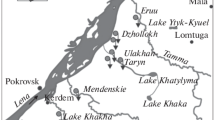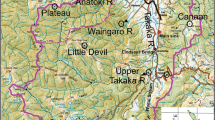Abstract
A resort near the border with Serbia in southwestern Romania has been associated with thermal springs for over 2,000 years. The thermal springs are a result of a geothermal anomaly developed in the Băile Herculane area, along a narrow and deep graben. In late 1970s, the Romanian government began the construction of the Cerna-Motru-Tismana hydropower system. Dams were built on these rivers, including their main tributaries, forming Cerna Lake and Motru Lake. Waters from the resulting impoundment, Cerna Lake, were directed through tunnels to Motru Lake and then to the power station at Tismana Lake. Due to this anthropogenic impact, the volume of water available to recharge the thermal water reservoir was substantially diminished. A study was requested by the government, to determine the effect of water withdrawal from the Cerna River on the thermal water reservoir and to evaluate potential hydrogeologic connections between the Cerna River, its tributaries, and the thermal water reservoirs. In 1988, an additional dam was built on the Cerna River, 5 km north of Băile Herculane (forming Prisaca Lake) to supply power, water, and recharge the thermal water reservoirs. Selected results of this study, with emphasis on the geology, hydrogeology, and recharge areas of the main springs of Mehedinţi Mountains south of Arsasca Valley, are presented in this paper. Several sinking streams were identified in the northern part of the study area, near the boundary between non karstifiable rocks and limestones. Monitoring of selected springs during dye studies performed in July 2010 is still ongoing. At the time of publication, no dye had been detected in the monitored springs. The long residence times reflects the complexity of the geology in the area. The sinking stream and the springs being monitored are in limestone units separated by 300 m of low primary permeability flysch deposits.




Similar content being viewed by others
References
Bandrabur G, Povară I, Bandrabur R (2010) Mehedinţi Mountains and Plateau. Karst Hydrogeology of Romania, Romania, pp 121–136
Bercia I, Bercia E, Nastaseanu S, Berza T, Iancu V, Stanoiu I, Hirtopanu I (1987) Foaia Obirşia Cloşani, 1: 50.000. Inst de Geologie si Geofizica, Bucureşti
Codarcea Al, Răileanu Gr (1968) Harta geologică 1:200 000, Baia de Aramă, L-34-XXIX. Inst Geol, Bucuresti
Cristescu I (1978) Tezaurul Cernei. Ed. Sport-Turism, Bucureşti
Liégeois JP, Berza T, Tatu M, Duchesne JC (1996) The Neoproterozoic Pan-African basement from the Alpine lower Danubian nape system (South Carpathians, Romania). Precambr Res 80:281–301
Năstăseanu S (1980) Géologie des Monts Cerna. Anuarul Institutului de Geologie şi Geofizică, LIV
Onac BP, Constantin S (2003) Europe, Balkans and Carpathians. In: Gunn J (ed) Encyclopedia of caves and karst science. Fitzroy Dearborn, New York, pp 328–331
Onac BP, Sumrall J, Tămaş T, Povară I, Kerns J, Dârmiceanu V, Vereş D, Lascu C (2009) The relationship between cave minerals and H2S-rich thermal waters along the Cerna Valley (SW Romania). Acta Carsologica 38(1):27–39
Ponta G (1998) Karst of Romania: Global Karst Correlation. In: Daoxian Y, Zaihua (eds) UNESCO/IUGS International Geologic Correlation Program Project 299, Geology, Climate, Hydrology and Karst Formation, Final Report, p 193–207
Ponta G (2003) Proposed modifications of the International Standard Legend for Large Scale Hydrogeological Maps in Carbonate Rocks, International Conference on Karst Hydrogeology and Ecosystems, Western Kentucky University, Bowling Green, Kentucky, p 16
Ponta G, Terteleac N (2006) Geology and dynamics of underground waters in Jiul de Vest–Cerna Valley, Băile Herculane (Romania). Archives of climate change in karst, Special Publication 10, In: Proceedings of the Symposium Climate Change: The Karst Record (IV), p 227–230
Povară I (1973) Contributions à la connaissance des sources thermo-minérales de Băile Herculane. Travaux de l’Institute de Spéologie “Emile Racovitza”, XII, p 337–348
Povară I (2001) Thermal Springs in Băile Herculane (Romania). In: LaMoreaux PE, Tanner JT (eds) Spring and bottled waters of the world: ancient history, source, occurrence, quality, and use. Springer, Berlin, pp 210–216
Povară I, Diaconu G, Goran C (1972) Observations préliminaires sur les grottes influencées par les eaux thermo-minérales de la zone Baile-Herculane. Travaux de l'Institute de Spéologie "Emile Racovitza" XI, pp 355–365
Povară I, Marin C, Niculescu T, Constantin S, Răduca F (1994) Establishment of the influence of Cerna River (Prisaca Lake) on thermal water reservoir from Băile Herculane (“Emil Racoviţă” Institute of Speleology Archive)
Povară I, Simion G, Marin C (2008) Thermomineral waters from the Cerna Valley Basin (Romania). Studia UBB Geologia, 53, pp 41–54
Preda I, Conovici M, Conovici Natalia (1974) Observaţii Hidrogeologice şi Geologice-Tehnice în Zona Isverna-Nadanova (Judeţul Mehedinţi) Analele Universităţii Bucureşti, Anul XXIII, pp 87–98
Simion G, Ponta G (1983) Contribuţii la Cunoasterea Carstului din Valea Cernei; Studii şi Cercetări de Speologie, 3, p 29–34; Editat de Casa Judeţeană Vâlcea a Personalului Didactic, Râmnicu Vâlcea
Simion G, Terteleac N, Ponta G (1979) Raport Asupra Studiilor Hidrogeologice Efectuate în Carstul Văii Cerna, în Vederea Stabilirii Influenţei Complexului Hidroenergetic Cerna-Motru-Tismana, asupra Zăcământului de Ape Termominerale de la Băile Herculane, Judeţul Caraş-Severin, Report. IGPSMS Archive
Simion G, Ponta G, Gaşpar E (1985) The dynamics of underground waters from Băile Herculane, Cerna Valley (Rumania). In: Proceedings of the International Meeting on Applied Problems of Karst Terrains, Annales de la Société Géologiques de Belgie, 108, p 245–249
Struckmeier W, Margat J (1995) Hydrogeological Maps A Guide and a Standard Legend, International Association of Hydrogeologists, vol 17. Heinz Heise, Hannover
Wynn J, Sumrall J, Onac BP (2010) Sulfur isotopic composition and the source of dissolved sulfur species in thermo-mineral springs of the Cerna Valley, Romania. Chem Geol 271:31–43
Acknowledgments
We thank the Domogled-Valea Cernei National Park for logistic support and permits to conduct our research.
Author information
Authors and Affiliations
Corresponding author
Rights and permissions
About this article
Cite this article
Ponta, G., Povară, I., Isverceanu, E.G. et al. Geology and dynamics of underground waters in Cerna Valley/Băile Herculane (Romania). Carbonates Evaporites 28, 31–39 (2013). https://doi.org/10.1007/s13146-013-0149-2
Accepted:
Published:
Issue Date:
DOI: https://doi.org/10.1007/s13146-013-0149-2




